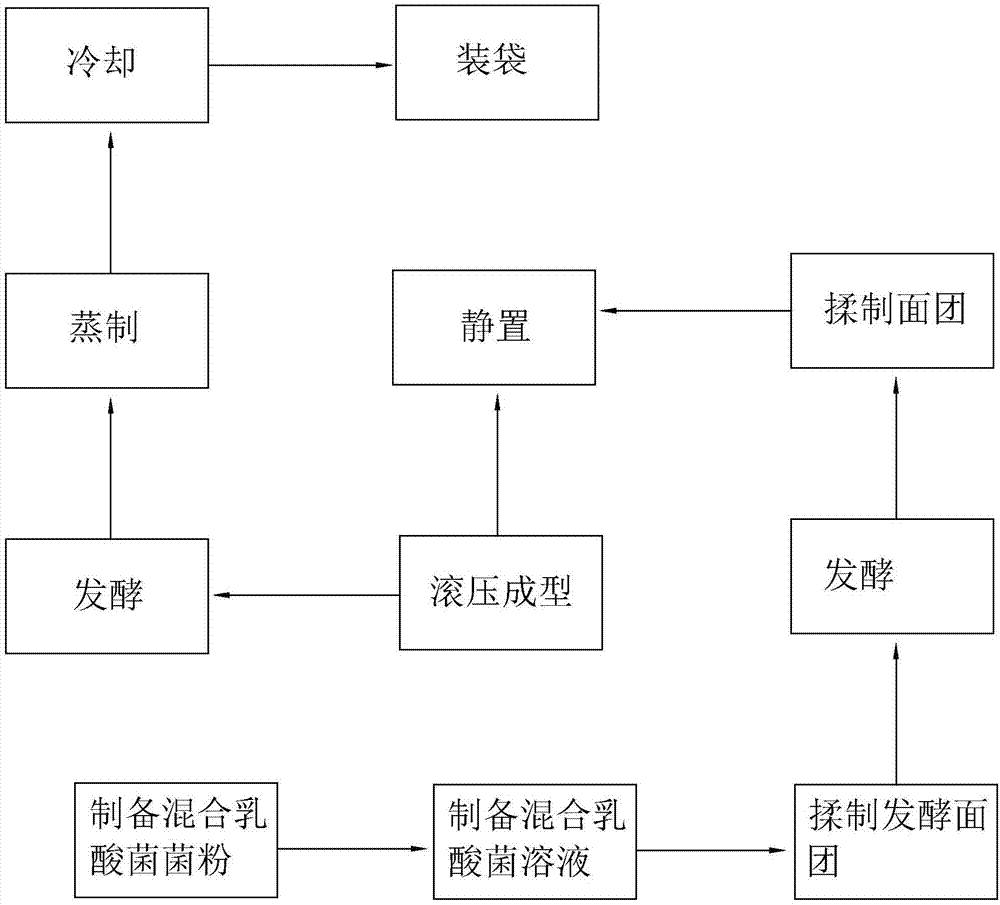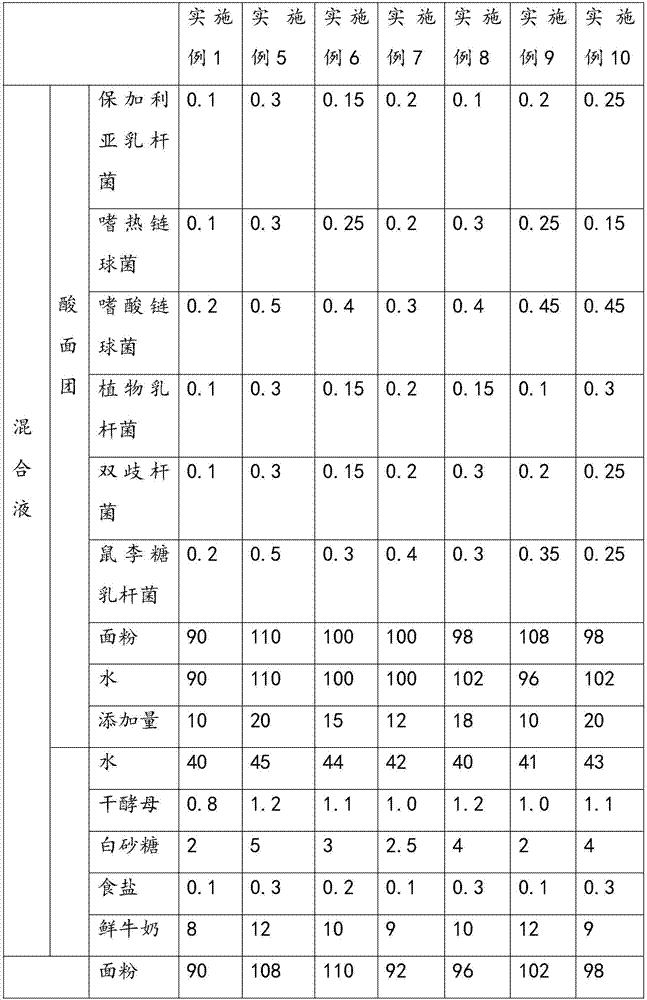Wheat germ steamed buns and processing method thereof
A technology of wheat germ and processing method, which is applied in the directions of food preservation, food ingredients as antimicrobial preservation, food ingredients as odor improver, etc. It can solve the problems of high water activity, short shelf life, complicated process, etc., and achieve reduction Effect of postprandial blood sugar, good therapeutic function, and high nutritional value
- Summary
- Abstract
- Description
- Claims
- Application Information
AI Technical Summary
Problems solved by technology
Method used
Image
Examples
Embodiment 1
[0037] A processing method of wheat germ steamed bread, such as figure 1 As shown, it mainly includes the following steps: preparing mixed lactic acid bacteria powder→preparing mixed lactic acid bacteria solution→kneading sourdough→fermenting→kneading dough→standing→rolling forming→fermenting→steaming→cooling→packing.
[0038]Take a clean container A, add 90 parts of flour to it, pour 90 parts of water into it and mix evenly, then add 0.1 part of Lactobacillus bulgaricus, 0.1 part of Streptococcus thermophilus, 0.2 parts of Lactobacillus acidophilus, 0.1 part of Lactobacillus plantarum, 0.1 part of Bifidobacterium and 0.2 part of Lactobacillus rhamnosus continue to stir until they are evenly mixed to form sourdough, and then container A and the sourdough therein are placed in an environment of 32°C for 8 hours. The pH is 4.2-4.8.
[0039] Take a clean container B, mix 10 parts of sourdough, 40 parts of water, 0.8 parts of yeast, 2 parts of white sugar, 0.1 parts of salt, and ...
Embodiment 2
[0047] A processing method of wheat germ steamed bread, such as figure 1 As shown, it mainly includes the following steps: preparing mixed lactic acid bacteria powder→preparing mixed lactic acid bacteria solution→kneading sourdough→fermenting→kneading dough→standing→rolling forming→fermenting→steaming→cooling→packing.
[0048] Take a clean container A, add 90 parts of flour to it, pour 90 parts of water into it and mix evenly, then add 0.1 part of Lactobacillus bulgaricus, 0.1 part of Streptococcus thermophilus, 0.2 parts of Lactobacillus acidophilus, 0.1 part of Lactobacillus plantarum, 0.1 part of Bifidobacterium and 0.2 part of Lactobacillus rhamnosus continue to stir until they are evenly mixed to form sourdough, and then container A and the sourdough therein are placed in an environment of 37°C for 10 hours. The pH is 4.2-4.8.
[0049] Take a clean container B, mix 10 parts of sourdough, 40 parts of water, 0.8 parts of yeast, 2 parts of white sugar, 0.1 parts of salt, an...
Embodiment 3
[0057] A processing method of wheat germ steamed bread, such as figure 1 As shown, it mainly includes the following steps: preparing mixed lactic acid bacteria powder→preparing mixed lactic acid bacteria solution→kneading sourdough→fermenting→kneading dough→standing→rolling forming→fermenting→steaming→cooling→packing.
[0058] Take a clean container A, add 90 parts of flour to it, pour 90 parts of water into it and mix evenly, then add 0.1 part of Lactobacillus bulgaricus, 0.1 part of Streptococcus thermophilus, 0.2 parts of Lactobacillus acidophilus, 0.1 part of Lactobacillus plantarum, 0.1 part of Bifidobacterium and 0.2 part of Lactobacillus rhamnosus continue to stir until they are evenly mixed to form sourdough, and then container A and the sourdough therein are placed in an environment of 35°C for 9 hours, the sourdough The pH is 4.2-4.8.
[0059] Take a clean container B, mix 10 parts of sourdough, 40 parts of water, 0.8 parts of yeast, 2 parts of white sugar, 0.1 part...
PUM
 Login to View More
Login to View More Abstract
Description
Claims
Application Information
 Login to View More
Login to View More - R&D
- Intellectual Property
- Life Sciences
- Materials
- Tech Scout
- Unparalleled Data Quality
- Higher Quality Content
- 60% Fewer Hallucinations
Browse by: Latest US Patents, China's latest patents, Technical Efficacy Thesaurus, Application Domain, Technology Topic, Popular Technical Reports.
© 2025 PatSnap. All rights reserved.Legal|Privacy policy|Modern Slavery Act Transparency Statement|Sitemap|About US| Contact US: help@patsnap.com



